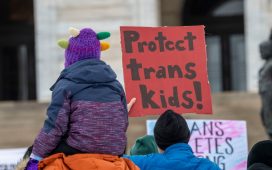The first weekend of March was the best weekend in a year. My son; my girlfriend, Julia; and I drove north from New York City to a cabin in the woods. We would spend the weekend by a frozen lake, ice-skating, snowshoeing, and cross-country skiing. It had been more than two weeks since my second vaccine shot. Julia had had her first shot the previous Monday. That weekend, movie theatres were opening in the city. Our over-all pandemic routines hadn’t changed much, but I was planning to take my first reporting trip in more than a year. We were at the finish line.
We got to the cabin after dark and skated on the lake under the stars. My son acknowledged that it had been worth spending five hours in the car. Saturday morning, we went skating again, but now he was cranky. He quit after one loop. After lunch, he said that he felt like taking a nap instead of snowshoeing. He slept for three hours, and then he was fine. I diagnosed oxygen poisoning. On Sunday, we went cross-country skiing and then drove home. Julia fell asleep in the car. When we got to my apartment, she went straight to bed and slept for twelve hours. By the time she got up, sniffling, we were worried and puzzled. We went to the mobile test site in my neighborhood. On the rapid antigen test, Julia and my son tested positive for the coronavirus; I was negative.
We split up inside my apartment, where each of us could claim a separate bedroom and bathroom. We started masking in the common spaces. I would cook meals, set them on the table for the two patients, and go out with the dog while they were eating. Meanwhile, the Centers for Disease Control and Prevention released new guidelines stating that fully vaccinated people who don’t have symptoms don’t have to quarantine after a known exposure to the virus. My son’s PCR test came back negative. On Thursday, March 11th, he and I got tested again; all our results were negative. We may never have noticed that he had been infected if Julia hadn’t become ill. That same day, Pfizer issued a press release saying that its vaccine was ninety-four per cent effective in preventing asymptomatic infection; this was on top of earlier data, which showed that it was ninety-seven per cent effective at preventing symptomatic illness. Considering that the chances of contracting the coronavirus are never a hundred per cent, even when a household member is infected, this suggested that my odds of being infected were somewhere in the statistical-error range. We relaxed precautions at home a bit, though we still stuck to our separate bedrooms and bathrooms.
Julia was miserable—exhausted, congested, and unable to smell or taste anything—for about a week. But, by Thursday, March 18th, the day the city officially cleared her to return to normal life, she had recovered. As an extra precaution, she tested again: her antigen and PCR tests came back negative. She felt well enough to paint the floors in her apartment. I walked in and started sneezing—an allergic reaction, clearly. The sniffles went away by the next morning. In the evening, we saw my college-student daughter. With Julia testing negative and me fully vaccinated, it felt like a safe celebration.
By the time I went to bed, I was sniffling again. I tossed and turned, wondering whether I might have exposed my daughter to the coronavirus. On Saturday morning, feeling a bit paranoid, I went to a rapid-testing site. My antigen test came back positive. The day before, I’d read an article titled “Don’t Be Surprised When Vaccinated People Get Infected,” but, of course, I thought this was an article about other people—it didn’t say, “Don’t be surprised if you get infected.” Julia and I biked for miles to a site that offered rapid PCR testing. Positive again. The next day, the regular PCR test came back positive.
For the next few days, it felt like the virus had taken over my head: my nose was constantly running, my eyes were inflamed, and I lost my sense of smell. Other than that, I didn’t feel particularly sick, just very tired. “It does sound like one of those breakthrough infections,” Eric Topol, a professor of molecular medicine at Scripps Research, told me by Zoom from San Diego. I described my symptoms to him in late March, after I had recovered. “The virus basically established residence in your nose—enough to cause loss of smell but not enough to cause other illnesses,” he said.
To Topol, there was nothing surprising about a case like mine. He and his colleagues had been looking at some seventy cases of breakthrough infections in San Diego. On March 23rd, The New England Journal of Medicine published a letter to the editor from a group of researchers in Southern California who had found that the risk of infection in fully vaccinated health-care workers there was higher than in the original vaccine trials, but still extremely low—around one per cent. Breakthrough infections have been reported in Florida, Michigan, and Washington. Much of the time, these cases are caught through routine testing of health-care workers, and the infections are asymptomatic. Symptomatic cases like mine are more unusual.
Without further tests, which are not easily available to an individual patient, it’s impossible to pinpoint the cause of my particular breakthrough infection, Topol told me. I might have had a weak immune response to the Pfizer vaccine. Or I could have been infected by one of the variants that have what scientists call immune-evasion features: the Brazilian, South African, and New York variants. Of these, B.1.351, the South African variant, which currently accounts for less than a per cent of COVID-19 cases in New York, appears to be marginally more likely to evade some of your antibodies, producing a mild infection. Less effective are the Brazilian variant (which makes up about one per cent of the cases in the city) and B.1.526, the New York variant. There is not yet enough data to know how many breakthrough infections are attributable to B.1.526, which is the most widespread variant in the city, accounting for more than forty-five per cent of COVID-19 cases.
“People with breakthrough infections really need to be studied,” Topol said. “The highest priority is to sequence the virus of the breakthrough infections.” Currently, labs in New York City are sequencing a fraction of the virus samples, every week. These samples are then cross-referenced with patient databases to see whether the person has been vaccinated against or was previously diagnosed with COVID-19. Statistics on breakthrough infections, and on the role of variants in these infections, come from this process. The problem, however, is that vaccinated people are unlikely to shed enough virus to sequence; this means that breakthrough infections may be passing under the radar.
I started looking around for people in the same boat as I was—fully vaccinated New Yorkers who had caught the virus. The first three I found all happened to be women who lived what they described as cloistered pandemic lives. Like me, they had been lucky enough to be able to work primarily from home; they did not use public transportation and did not go to restaurants, indoor or outdoor. All three had barely changed their life habits after being vaccinated, in part because they were waiting for the rest of their families and social circles to be vaccinated, too.
Emily Bell, a professor at Columbia Journalism School, lives in a sixth-floor Morningside Heights apartment with her husband and sixteen-year-old son. She had her second vaccine shot on February 26th; she had tried to avoid using her building’s elevator or hosting any guests in the previous year. “I have friends who are more careful, but not many,” Bell told me by Zoom. She and her husband are both fifty-five; he has high blood pressure, and she is overweight. “We were not unnecessarily cautious,” she said. On the day of Bell’s second shot, her husband tested positive for the coronavirus; Bell and their son were negative. She started thinking about booking tickets to Britain to visit her eighty-six-year-old mother, whom she hadn’t seen in more than a year. She got tested again, one week after her second shot: positive. Bell’s symptoms were mild. Her biggest complaint was a loss of stamina, which still persisted when we spoke, four weeks after Bell got her test result.
Tamara Sussman, a forty-four-year-old psychologist and a professor at Columbia University Medical Center, who lives in Sunnyside, Queens, received her second vaccine shot on February 2nd. Her mother, who was also fully vaccinated, started coming over to see her grandkids, who are four and seven; this was the only change to Sussman’s pre-vaccination routine. In mid-March, Sussman found out that someone she had seen six days earlier had tested positive for the coronavirus. Sussman’s test came back negative. A week after that, she felt unwell—stuffed up and “really knocked out, really exhausted”—and got tested. This time, she was positive, and so were her kids.
Julia Kunin, a sixty-year-old visual artist who lives in Williamsburg, received her second vaccine shot on January 29th. After she was fully vaccinated for two weeks, she gave herself permission to take the subway, twice; she wore two masks and a face shield. She took an Uber once. She visited a few galleries on the Lower East Side, always making sure that everyone else in the gallery was masked, and each visit lasted less than ten minutes. On February 16th, Kunin spent five hours at her own show. The windows and the door of the gallery stayed open, and there were no more than three visitors at a time. Everyone wore a mask. On February 17th, a friend with whom she had chatted at a gallery—both of them double-masked—told Kunin that she had tested positive. “I thought, Let me be a good citizen, and went and got tested,” Kunin told me over Zoom. The test came back positive. Kunin, who has asthma and uses an inhaler regularly, went on to develop respiratory symptoms. She required treatment with corticosteroids. It was more than a month before she finally felt better.
Looking for a specific reason—an exact day or person—to account for infection is generally a fool’s errand. Sussman, Bell, and I all have kids of various ages, and hypotheses we might attach to them; Kunin does not. But all of our cases are mysteries, events both exceedingly rare and entirely expected. The latest real-world data released by the C.D.C. indicate that the Moderna and Pfizer vaccines are ninety-per-cent effective in preventing infection, including asymptomatic ones (these numbers come from eight locations in the United States, but do not include New York). People who are fully vaccinated could get infected, but at one-tenth of the rate of unvaccinated people; as more people are vaccinated, cases like ours should dwindle in number.








